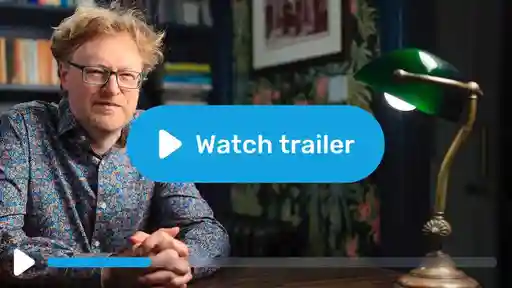Guides • Perfecting your Craft
Last updated on Oct 21, 2024
How to Write a Short Story in 8 Simple Steps
The Reedsy Network
Reedsy's publishing freelancers come from all over the world and specialize in various disciplines, from editing to design.
View profile →This post is written by UK writer Robert Grossmith. His short stories have been widely anthologized, including in The Time Out Book of London Short Stories, The Best of Best Short Stories, and The Penguin Book of First World War Stories. You can collaborate with him on your own short stories here on Reedsy.
The joy of writing short stories is, in many ways, intertwined with its limitations. Developing characters, conflict, and a premise within a few pages is a thrilling challenge that many writers relish — even after they've "graduated" to long-form fiction.
In this article, I’ll take you through the process of writing a short story, from conception to the final draft. But first, let’s talk about what makes a short story different from a novel.
What is a short story?
A short story is a brief fictional piece that usually revolves around a dramatic episode or epiphany, which aims to evoke a single powerful emotion or insight. Compared to novels, short stories typically feature:
- Fewer characters;
- A single point of view;
- One main storyline without subplots;
- And minimal backstory or exposition.
While novels typically average around 80,000 words, short stories are significantly more concise.
How long should a short story be?
The simple answer to this question, of course, is that the short story is shorter than the novel, usually coming in between 1,000-10,000 words. Any shorter and you’re into flash fiction territory. Any longer and you’re approaching novella length.
But don't let the brevity fool you. In the hands of a skilled wordsmith, short stories can still feature immersive worlds, nuanced characters, and interesting narrative arcs. Like novels, they can (and should) contain the basic ingredients of storytelling…

FREE COURSE
How to Craft a Killer Short Story
From pacing to character development, master the elements of short fiction.
What are the elements of a short story?
Short stories should include the elements that make a narrative compelling: a solid plot structure, an interesting character arc, a central theme or message, and more. Let’s look at some of them:
🧑🦱Character: A protagonist with interesting goals and desires is essential to your story. Whether they’re an insecure teenager grappling with their parents' divorce or a bold hero trying to retrieve a treasure from another planet, make sure that your character’s unique personality and motives draw readers in.
🥊Conflict: A story is all about how characters overcome inner and outer obstacles, and watching how they evolve as they face these challenges. If your protagonist achieves their goal quickly and easily, there’s no story. So make sure your protagonist faces a dark night of the soul or intergalactic villain before they get what they’re looking for.
🕸️Plot: A story is typically built around several plot points: the inciting incident where your character starts pursuing their goal, the rising action (and conflict) that follows, leading up to the climax and resolution. While short stories usually have fewer plot points, they still need a solid beginning, middle, and end to feel complete.
👀 Point-of-View (POV): The POV determines how the reader experiences the story. Most short stories are written from the first-person POV ("I") to put the reader directly inside the protagonist’s thoughts, or third-person limited (which sticks to one character’s perspective, giving us their inner world but with a bit more distance. Short stories offer a great opportunity to experiment with less common POVs, like second person or even fourth person, which can bring a truly unique feel to the narrative.
🏙️Setting: Is your story placed in 1950s downtown Manhattan or on a futuristic planet? The setting is the physical, historical, and social backdrop of your narrative. In short stories, setting often takes a backseat to action, but it's still important and should be described as vividly as possible.
🤔Theme: The theme is the central idea or message of the story, often beginning with a question (e.g., How might a teenager grieve the separation of their parents?). Your story can either provide an answer or leave the question open for further reflection, but it should add to the conversation around a social theme or explore some aspect of the human condition.
How to write a short story
Now that we've identified some key ingredients, let's see how to combine them together to craft a compelling narrative. Here are eight steps you can follow:
1. Pick a simple, central premise
A short story can begin life in all sorts of ways.
It may be suggested by a simple but powerful image that imprints itself on the mind. It may derive from the contemplation of a particular character type — someone you know perhaps — that you’re keen to understand and explore. It may arise out of a memorable incident in your own life.
But in most of these cases, it seems to me, the first heartbeat (the “throb,” as Vladimir Nabokov puts it) of a new story is similar: it’s a brief capsule premise that contains within itself the germ of a more complex and sophisticated narrative.
For example:
- Kafka began “The Metamorphosis” with the intuition that a premise in which the protagonist wakes one morning to find he’s been transformed into a giant insect would allow him to explore questions about human relationships and the human condition.
- Herman Melville’s “Bartleby the Scrivener” takes the basic idea of a lowly clerk who decides he will no longer do anything he doesn’t personally wish to do, and turns it into a multi-layered tale capable of a variety of interpretations.
When I look back on some of my own short stories, I find a similar dynamic at work: a simple originating idea slowly expands to become something more nuanced and less formulaic.

So how do you find this “first heartbeat” of your own short story? Here are several ways to do so.
Experiment with writing prompts
Eagle-eyed readers will notice that the story premises mentioned above actually have a great deal in common with writing prompts like the ones put forward each week in Reedsy’s short story competition. Try it out! These prompts are often themed in a way that’s designed to narrow the focus for the writer so that one isn’t confronted with a completely blank canvas.
Turn to the originals
Take a story or novel you admire and think about how you might rework it, changing a key element. (“Pride and Prejudice and Vampires” is perhaps an extreme product of this exercise.) It doesn’t matter that your proposed reworking will probably never amount to more than a skimpy mental reimagining — it may well throw up collateral narrative possibilities along the way.
Keep a notebook
Finally, keep a notebook in which to jot down stray observations and story ideas whenever they occur to you. Again, most of what you write will be stuff you never return to, and it may even fail to make sense when you reread it. But lurking among the dross may be that one rough diamond that makes all the rest worthwhile.
2. Build a small but distinct cast of characters
Like I mentioned earlier, short stories usually contain far fewer characters than novels. Readers also need to know far less about the characters in a short story than we do in a novel (sometimes it’s the lack of information about a particular character in a story that adds to the mystery surrounding them, making them more compelling).

Yet it remains the case that creating memorable characters should be one of your principal goals. Think of your own family, friends and colleagues. Do you ever get them confused with one another? Probably not.
Your dramatis personae should be just as easily distinguishable from one another, either through their appearance, behavior, speech patterns, or some other unique trait. If you find yourself struggling, a character profile template like the one you can download for free below is particularly helpful in this stage of writing.
For example:
- “The Yellow Wallpaper” by Charlotte Perkins Gilman features a cast of two: the narrator and her husband. How does Gilman give her narrator uniquely identifying features?
- “The Tell-Tale Heart” by Edgar Allan Poe features a cast of three: the narrator, the old man, and the police. How does Poe use speech patterns in dialogue and within the text itself to convey important information about the narrator?
- “A Good Man Is Hard to Find” by Flannery O’Connor is perhaps an exception: its cast of characters amounts to a whopping (for a short story) nine. How does she introduce each character? In what way does she make each character, in particular The Misfit, distinct?
3. Begin writing close to the end
 It was Kurt Vonnegut who said you should start as close to the story end as possible.
It was Kurt Vonnegut who said you should start as close to the story end as possible.
He’s right: avoid the preliminary exposition or extended scene-setting. Begin your story by plunging straight into the heart of the action. What most readers want from a story is drama and conflict, and this is often best achieved by beginning in media res. You have no time to waste in a short story. The first sentence of your story is crucial, and needs to grab the reader’s attention to make them want to read on.
One way to do this is to write an opening sentence that makes the reader ask questions. For example, Kingsley Amis once said, tongue-in-cheek, that in the future he would only read novels that began with the words: “A shot rang out.”
This simple sentence is actually quite telling. It introduces the stakes: there’s an immediate element of physical danger, and therefore jeopardy for someone. But it also raises questions that the reader will want answered. Who fired the shot? Who or what were they aiming at, and why? Where is this happening?
We read fiction for the most part to get answers to questions. For example, if you begin your story with a character who behaves in an unexpected way, the reader will want to know why he or she is behaving like this. What motivates their unusual behavior? Do they know that what they’re doing or saying is odd? Do they perhaps have something to hide? Can we trust this character?
As the author, you can answer these questions later (that is, answer them dramatically rather than through exposition). But since we’re speaking of the beginning of a story, at the moment it’s enough simply to deliver an opening sentence that piques the reader’s curiosity, raises questions, and keeps them reading.
FREE RESOURCE
Short Story Template
Write a tightly-plotted short story with our step-by-step guide.
4. Shut out your internal editor
“Anything goes” should be your maxim when embarking on your first draft.
By that, I mean: kill the editor in your head and give your imagination free rein. Remember, you’re beginning with a blank page. Anything you put down will improve what’s currently there, which is nothing. And there’s a prescription for any obstacle you might encounter at this stage of writing.
- Worried that you’re overwriting? Don’t worry. It’s easier to cut material in later drafts once you’ve sketched out the whole story.
- Got stuck, but know what happens later? Leave a gap. There’s no necessity to write the story sequentially. You can always come back and fill in the gap once the rest of the story is complete.
- Have a half-developed scene that’s hard for you to get onto the page? Write it in note form for the time being. You might find that it relieves the pressure of having to write in complete sentences from the get-go.
Most of my stories were begun with no idea of their eventual destination, but merely an approximate direction of travel. To put it another way, I’m a ‘pantser’ (flying by the seat of my pants, making it up as I go along) rather than a planner. There is, of course, no right way to write your first draft. What matters is that you have a first draft on your hands at the end of the day.
5. Finish the first draft
It’s hard to overstate the importance of the ending of a short story: it can rescue an inferior story or ruin an otherwise superior one.
If you’re a planner, you will already know the broad outlines of the ending. If you’re a pantser like me, you won’t — though you’ll hope that a number of possible endings will have occurred to you in the course of writing and rewriting the story!
In both cases, keep in mind that what you’re after is an ending that’s true to the internal logic of the story without being obvious or predictable. What you want to avoid is an ending that evokes one of two reactions:
- “Is that it?” aka “The author has failed to resolve the questions raised by the story.”
- “WTF!” aka “This ending is simply confusing.”
6. Edit the short story
Like Truman Capote said, “Good writing is rewriting.”
Once you have a first draft, the real work begins. This is when you move things around, tightening the nuts and bolts of the piece to make sure it holds together and resembles the shape it took in your mind when you first conceived it.
In most cases, this means reading through your first draft again (and again). In this stage of editing, think to yourself:
- Which narrative threads are already in place?
- Which may need to be added or developed further?
- Which need to perhaps be eliminated altogether?
All that’s left afterward is the final polish. Here’s where you interrogate every word, every sentence, to make sure it’s earned its place in the story:
- Is that really what I mean?
- Could I have said that better?
- Have I used that word correctly?
- Is that sentence too long?
- Have I removed any clichés?
Trust me: this can be the most satisfying part of the writing process. The heavy lifting is done, the walls have been painted, the furniture is in place. All you have to do now is hang a few pictures, plump the cushions and put some flowers in a vase.
Hire an expert short story editor.
Angela Yuriko S.
Available to hire
Publishing coach, multi Bram Stoker Awards® Winner+, publisher of Space and Time and Authortunities, a calendar of author opportunities.
Chris U.
Available to hire
I am an expert in genre fiction, with years of experience evaluating short fiction. I want your wildest stories to find a published home.
Elise G.
Available to hire
Developmental editor, copy editor, proofreader for literary fiction, short stories, non-fiction. Worked at Houghton Mifflin Harcourt.
7. Share the story with beta readers
Eventually, you may reach a point where you’ve reread and rewritten your story so many times that you simply can’t bear to look at it again. If this happens, put the story aside and try to forget about it.
When you do finally return to it, weeks or even months later, you’ll probably be surprised at how the intervening period has allowed you to see the story with a fresh pair of eyes. And whereas it might have felt like removing one of your own internal organs to cut such a sentence or paragraph before, now it feels like a liberation.
The story, you can see, is better as a result. It was only your bloated appendix you removed, not a vital organ.
It’s at this point that you should call on the services of beta readers if you have them. This can be a daunting prospect: what if the response is less enthusiastic than you’re hoping for? But think about it this way: if you’re expecting complete strangers to read and enjoy your story, then you shouldn’t be afraid of trying it out first on a more sympathetic audience.
This is also why I’d suggest delaying this stage of the writing process until you feel sure your story is complete. It’s one thing to ask a friend to read and comment on your new story. It’s quite another thing to return to them sometime later with, “I’ve made some changes to the story — would you mind reading it again?”
8. Submit the short story to publications
So how do you know your story’s really finished? This is a question that people have put to me. My reply tends to be: I know the story’s finished when I can’t see how to make it any better.
This is when you can finally put down your pencil (or keyboard), rest content with your work for a few days, then submit it so that people can read your work.
Just like with novels, you can either publish your short stories through a publication or self-publish. If you opt for the traditional route, you can explore some of the top publications that accept short stories, like Guernica or Daily Science Fiction. For a wider search, you can also check out directories on platforms like Reedsy, Duotrope, or Poets & Writers to find the perfect match for your submission.
Another option is to submit your work to some of the hundreds of active short story contests. In some cases, your story may be published just by participating, or if it gets shortlisted or wins. Winning can also come with a prize, making contests a great opportunity to get both recognition and rewards!
Finally, you can also simply self-publish your short stories on your blog. Many successful indie-authors kickstarted their career this way.
One more note on the submission process. The truth is, in my experience, there’s actually no such thing as a final draft. Even after you’ve submitted your story somewhere — and even if you’re lucky enough to have it accepted — there will probably be the odd word here or there that you’d like to change.
Don’t worry about this. Large-scale changes are probably out of the question at this stage, but a sympathetic editor should be willing to implement any small changes right up to the time of publication.
Overall, if you follow the steps in this post, you’ll be well on your way to write your piece. I already mentioned a few short story examples, but let’s look into a few more so that you can really get a sense of the medium.
3 examples of famous short stories
Plenty of amazing short stories are published every week, spanning all kinds of genres — from literary fiction to fantasy, to creative nonfiction, and everything in between. Some short stories, however, have become classics. Let's quickly look at a few of them:
In a Grove by Ryūnosuke Akutagawa
In a bamboo forest near Kyoto, a samurai is found dead. What happened? The mystery unfolds through various unreliable characters who recount the events leading to the samurai’s death, but the truth remains elusive. This short story is so captivating that it has been adapted for film many times (take that, novels!).
Gooseberries by Anton Chekhov
While taking shelter from the rain, Ivan chats with his hunting friend about his brother's fate. He shares how he dreamed of buying a farm and becoming a landowner, believing it would bring him happiness. But behind the farm’s walls, he’s quite miserable. This powerful tale from a Russian master will leave you pondering the idea of human happiness for a long time.
Lamb to the Slaughter by Roald Dahl
Let me conclude with a story rich in irony. In this narrative, Mary Maloney's life takes a dramatic turn when her husband returns from work and announces his intention to leave her. In a trance-like state, she kills him with the frozen leg of lamb she was preparing for dinner. Then calls the police. Upon their arrival to investigate… Well, you’ll have to read it to find out what happens. You won’t forget this short story easily.
I hope you enjoyed this deep dive into the world of short narratives and feel empowered to challenge yourself in this wonderful literary medium. For the next installment of this guide, let's zoom in on the topic of how to get your short story published.
Robert Grossmith is a UK writer based near Norwich. In addition to his short stories, he has also published two novels, poems, scholarly articles, and (as Bob Grossmith) book reviews. He has a BA in Philosophy & Psychology and a PhD on Vladimir Nabokov, and worked for many years as a lexicographer at Collins Dictionaries. He is now semi-retired and works part-time as a freelance fiction editor for authors.

